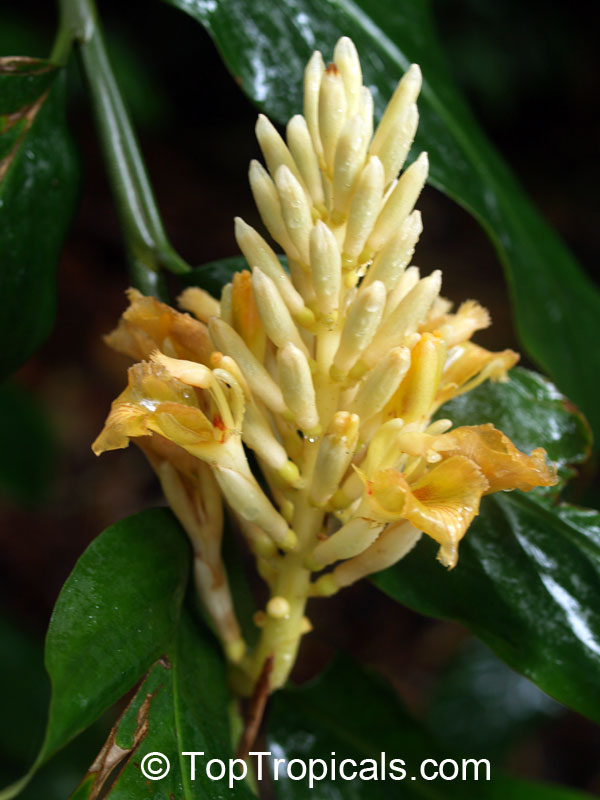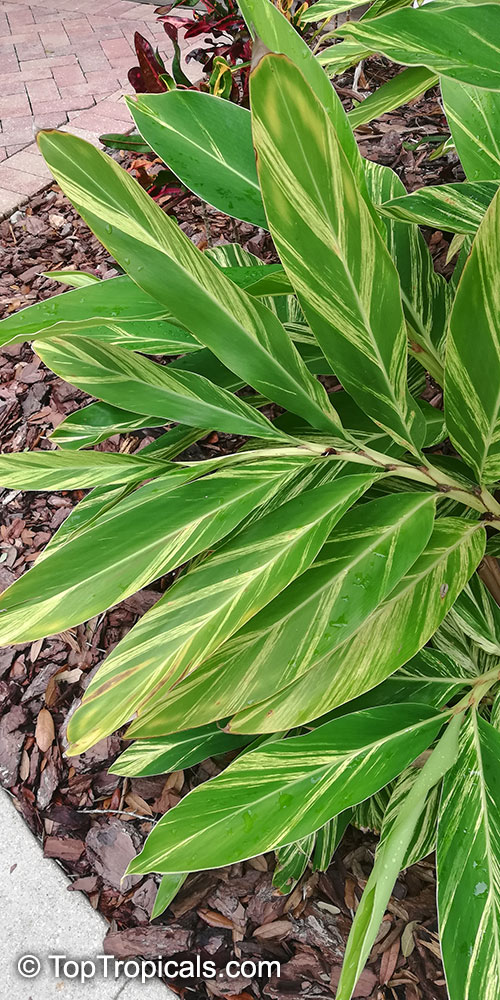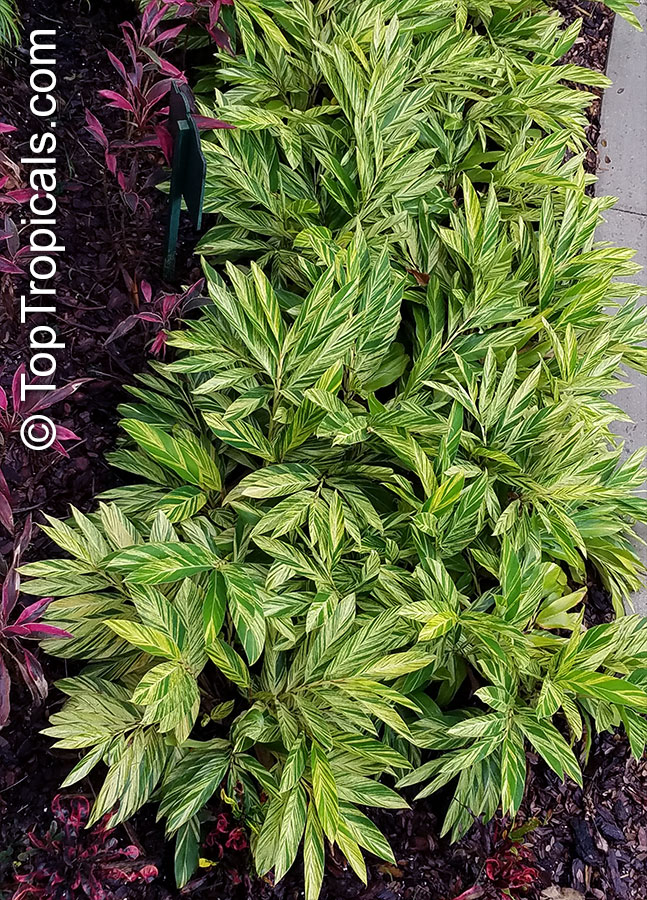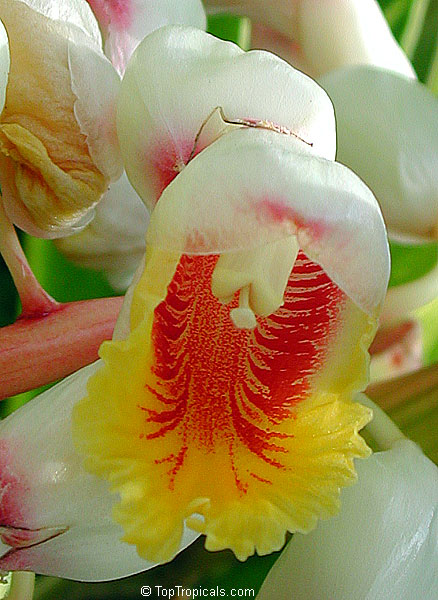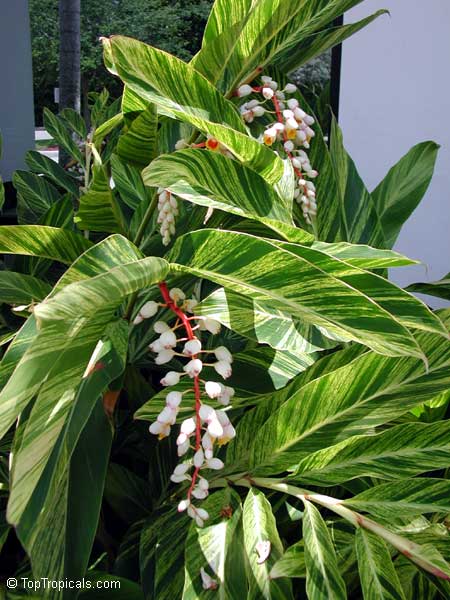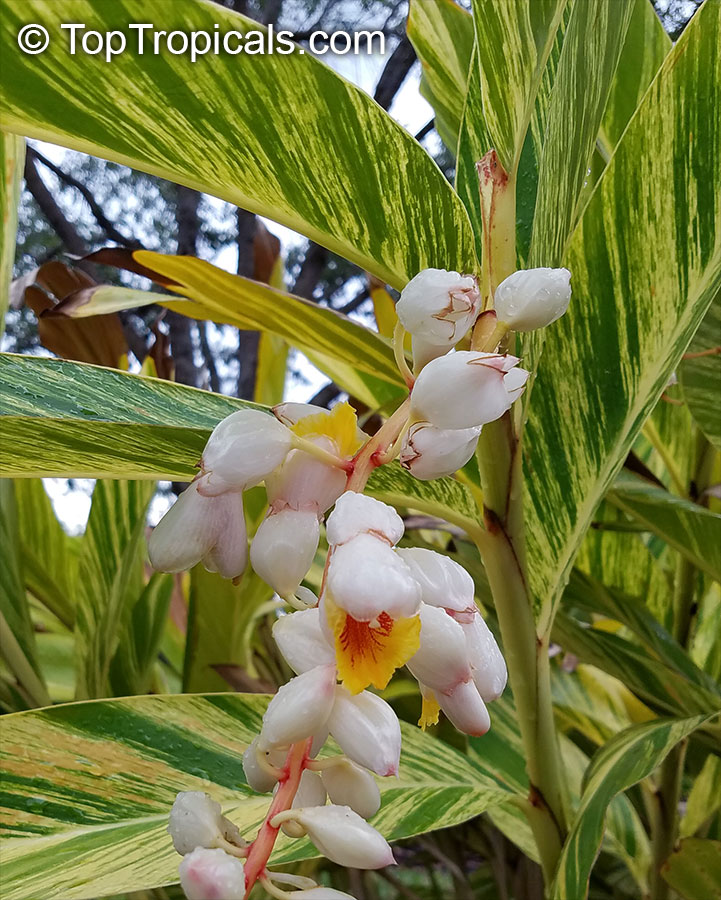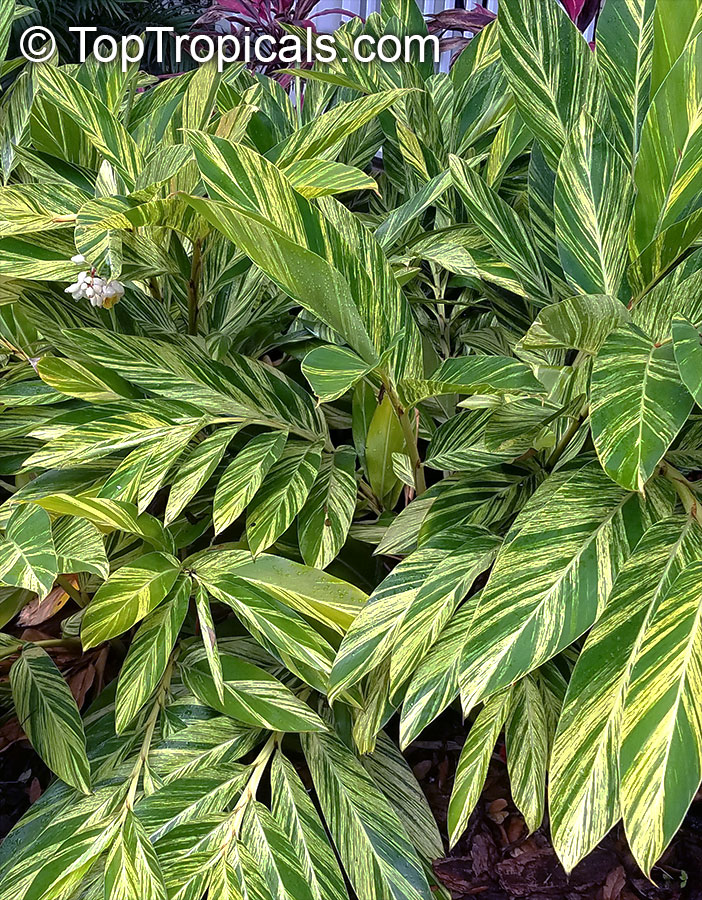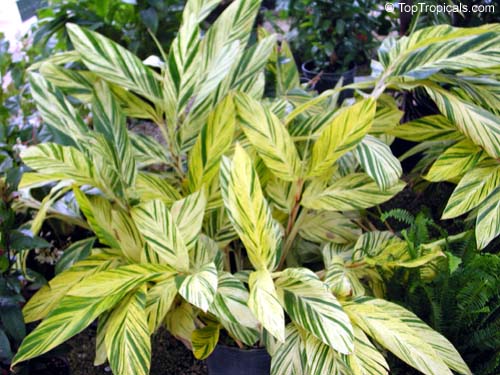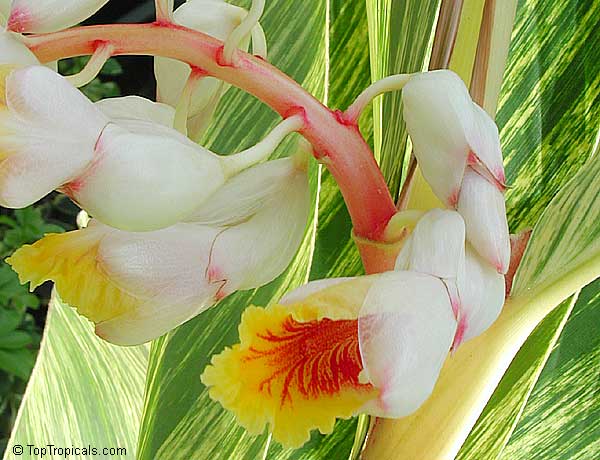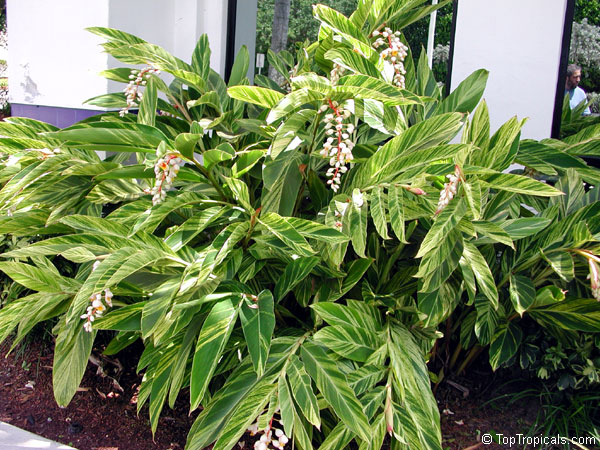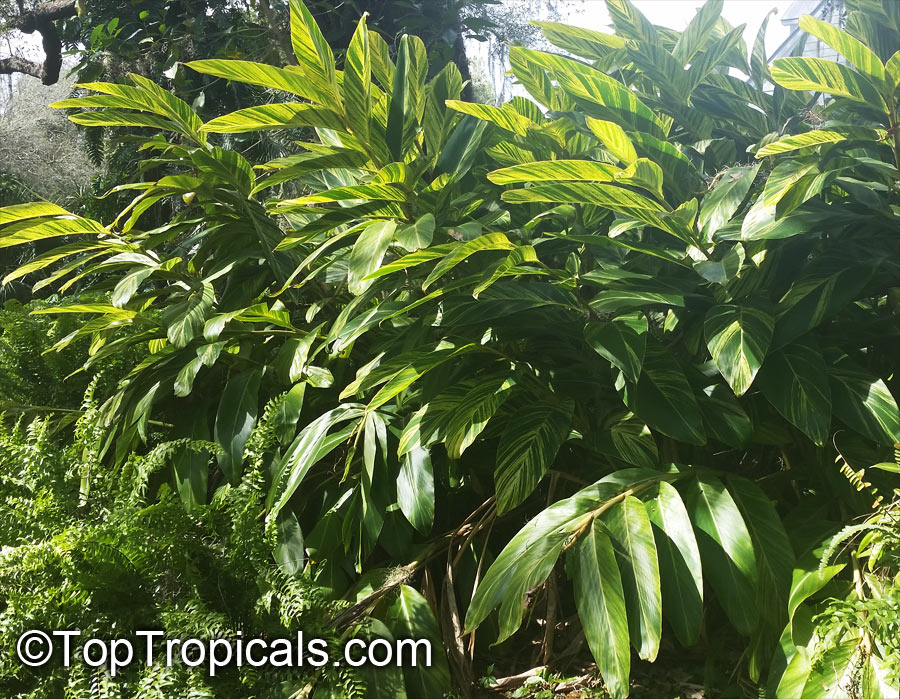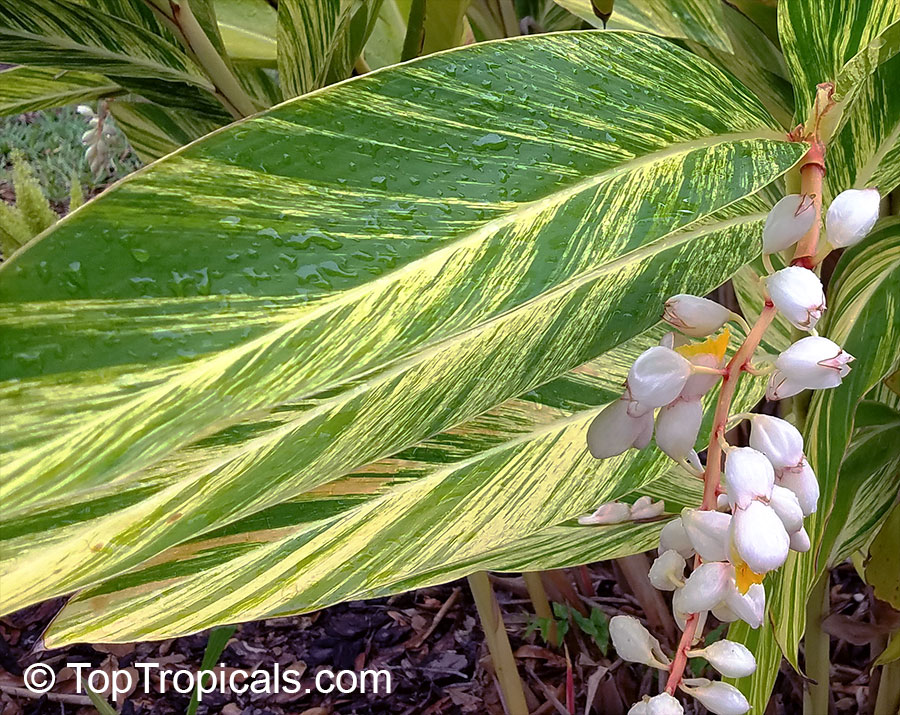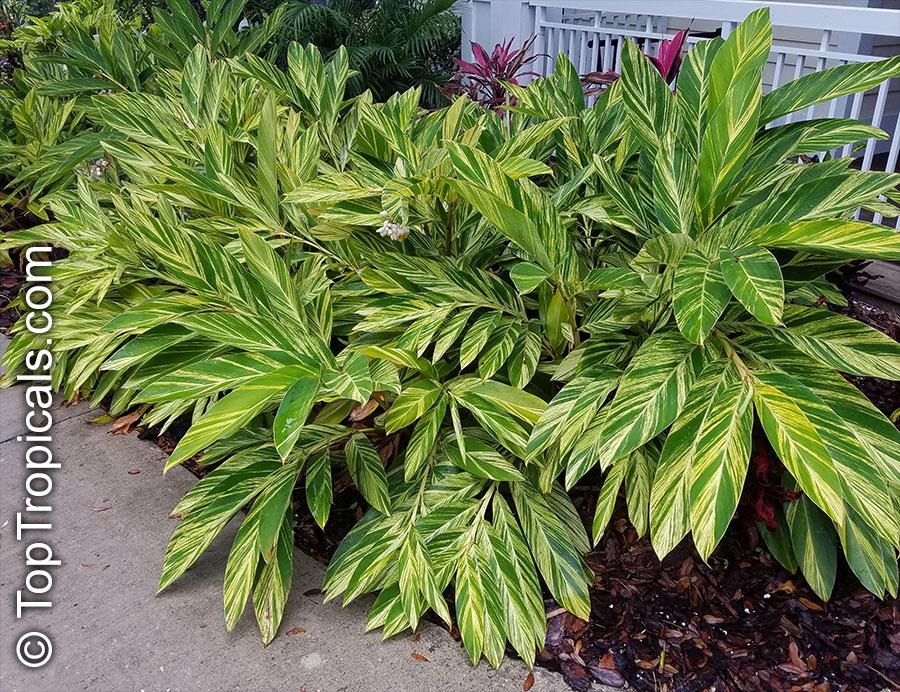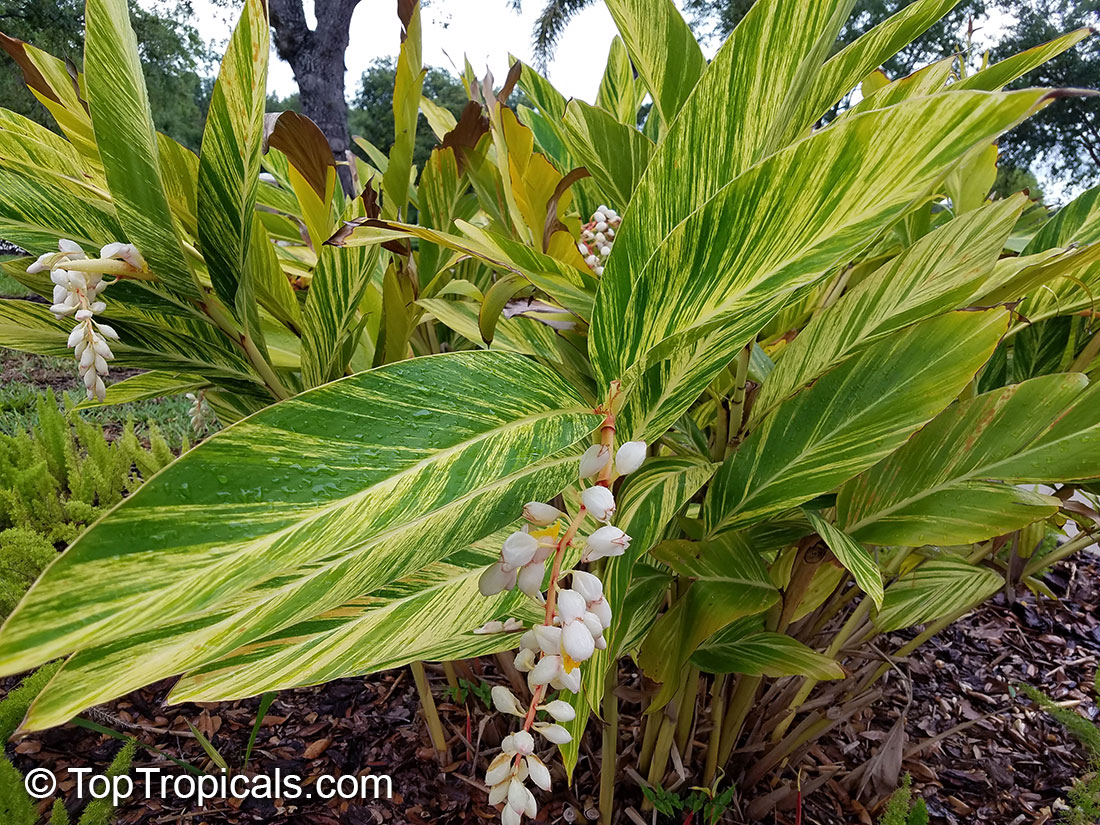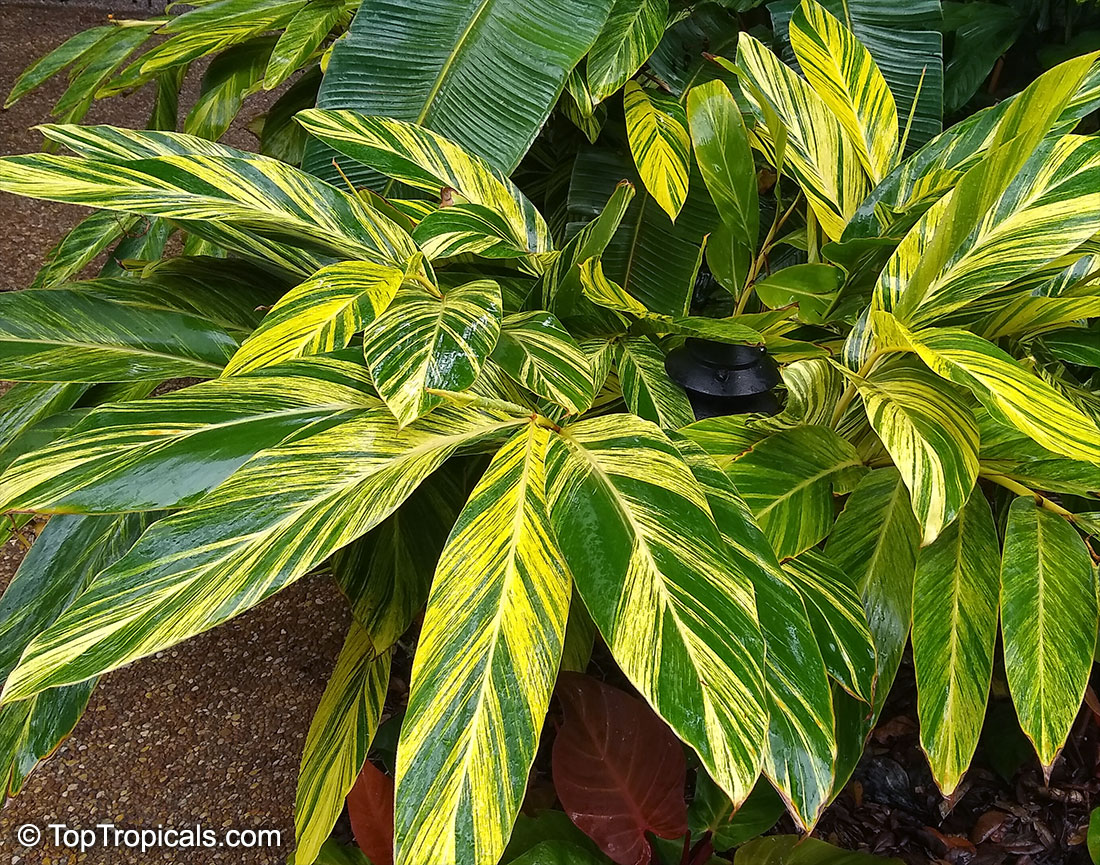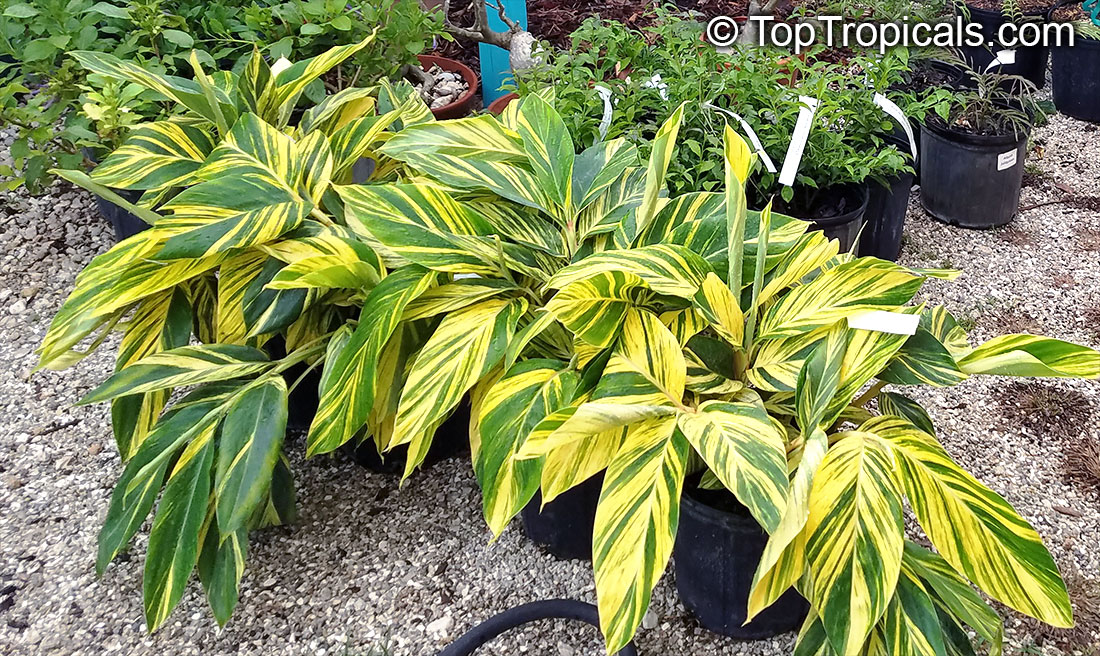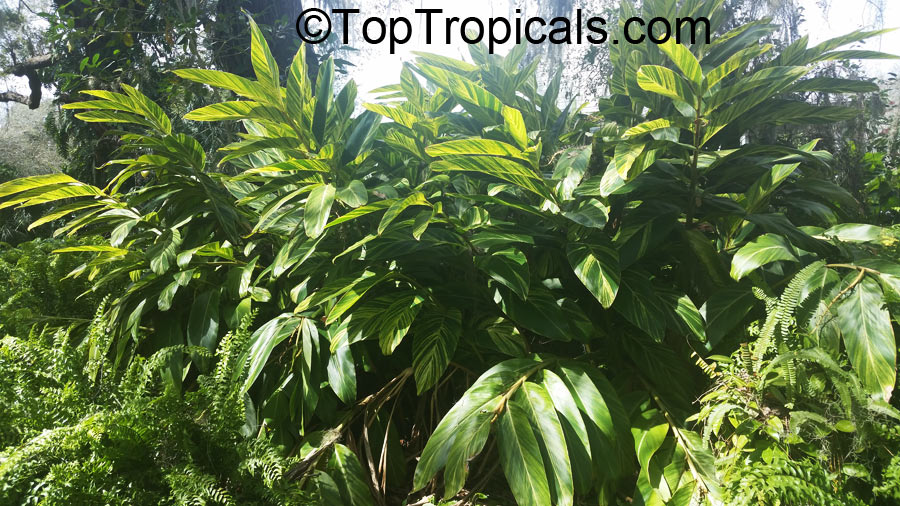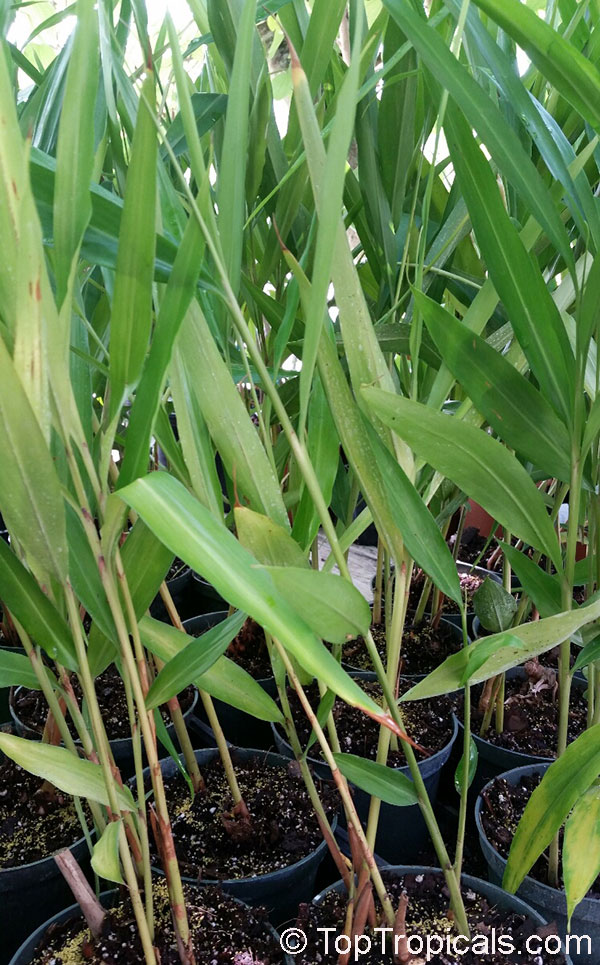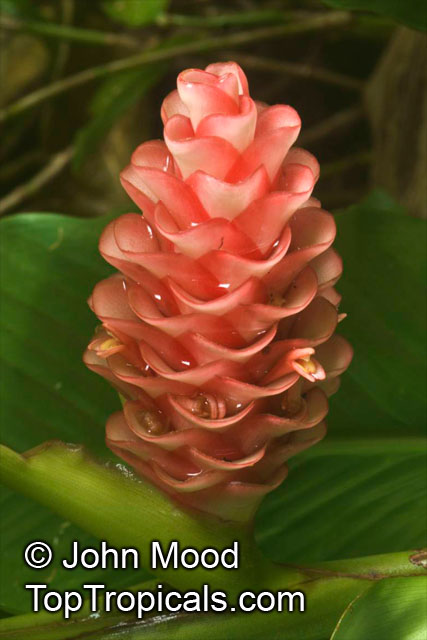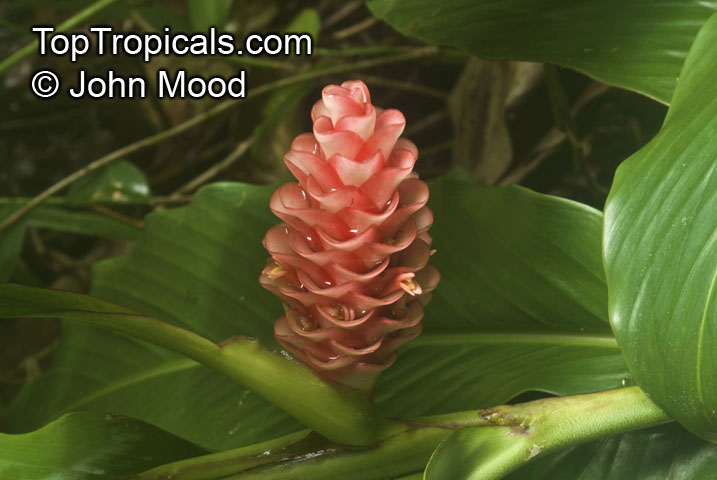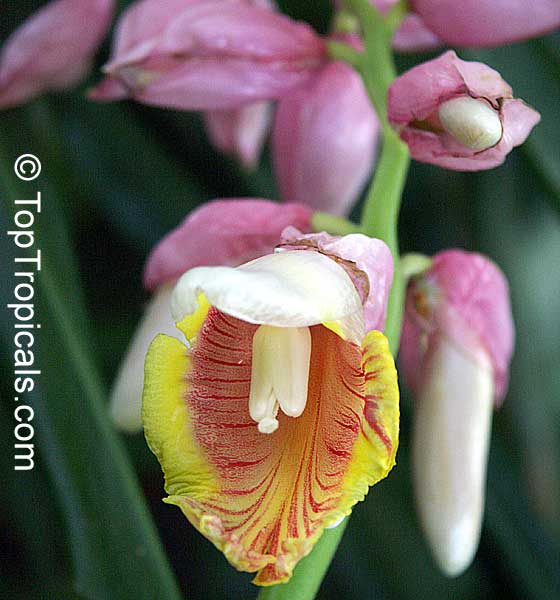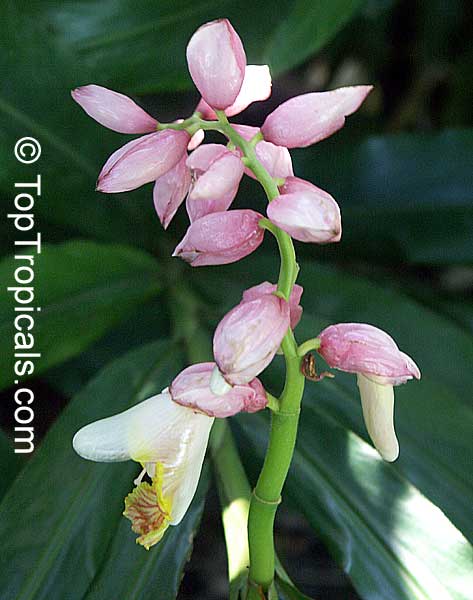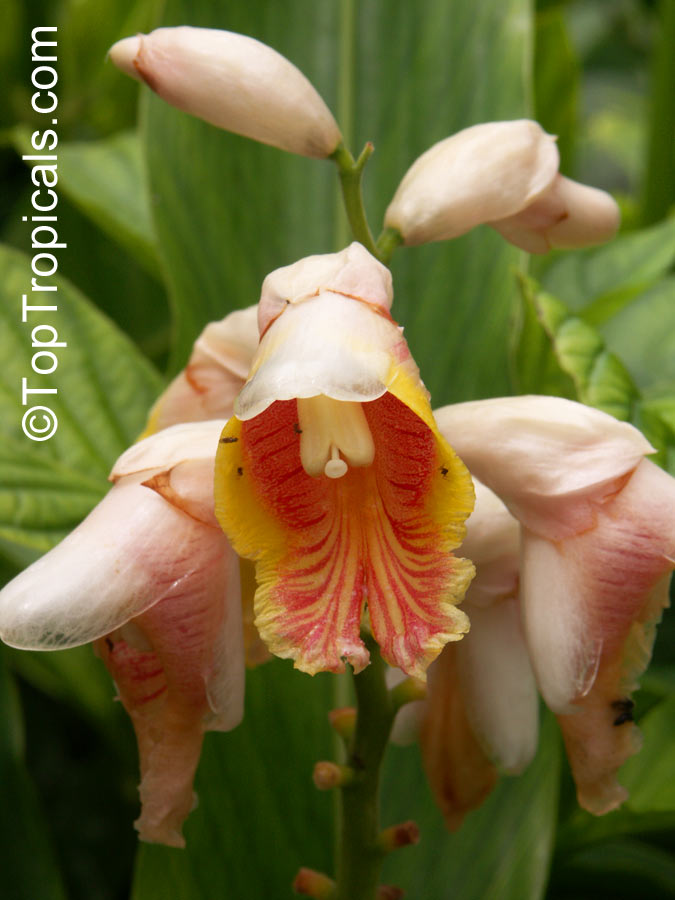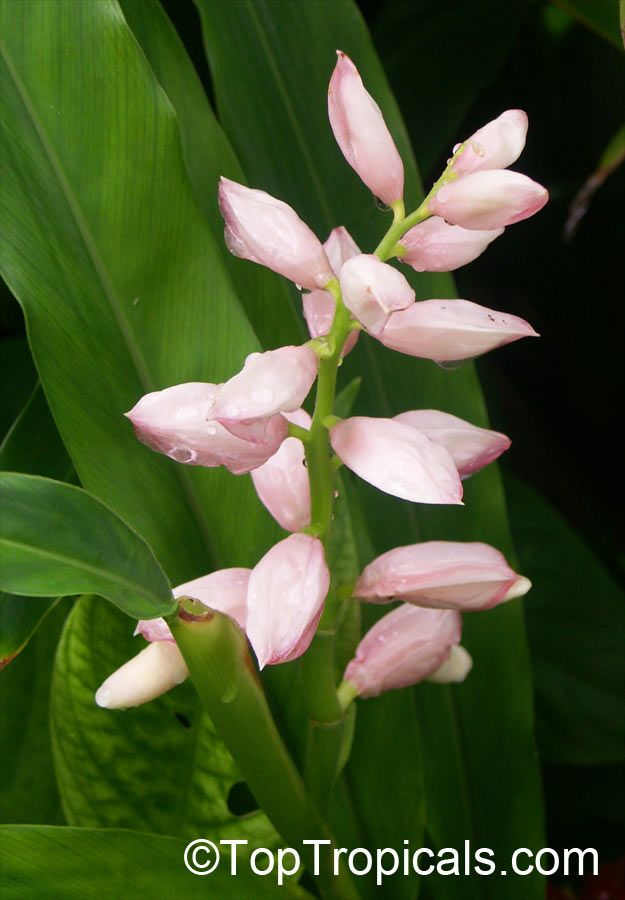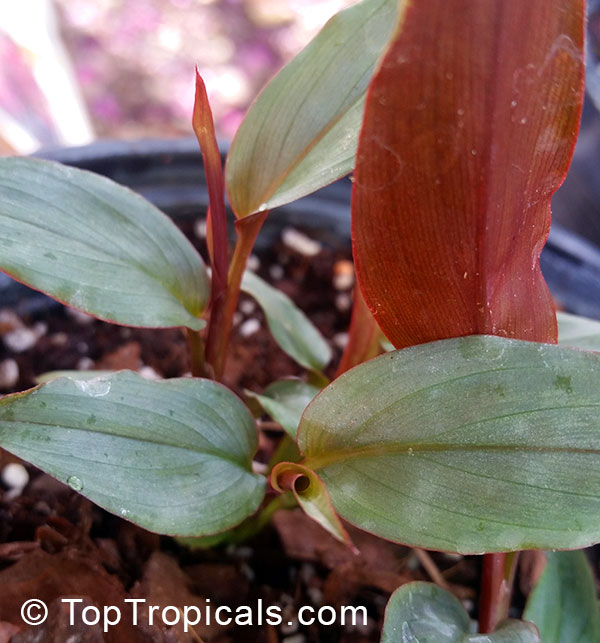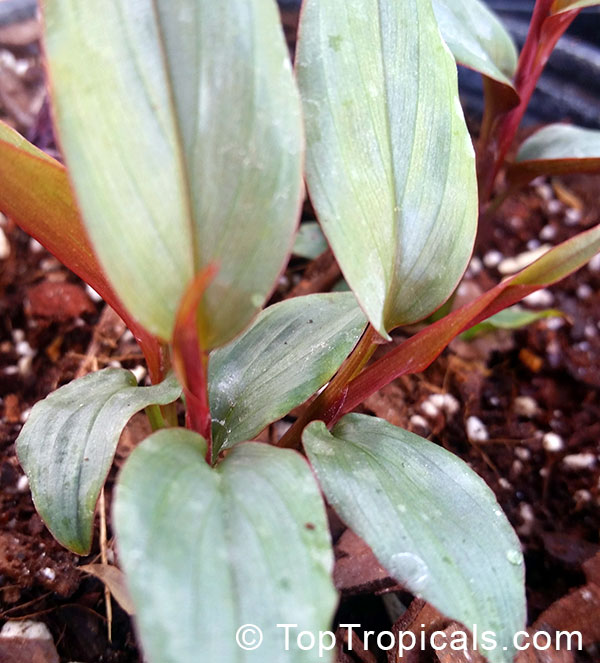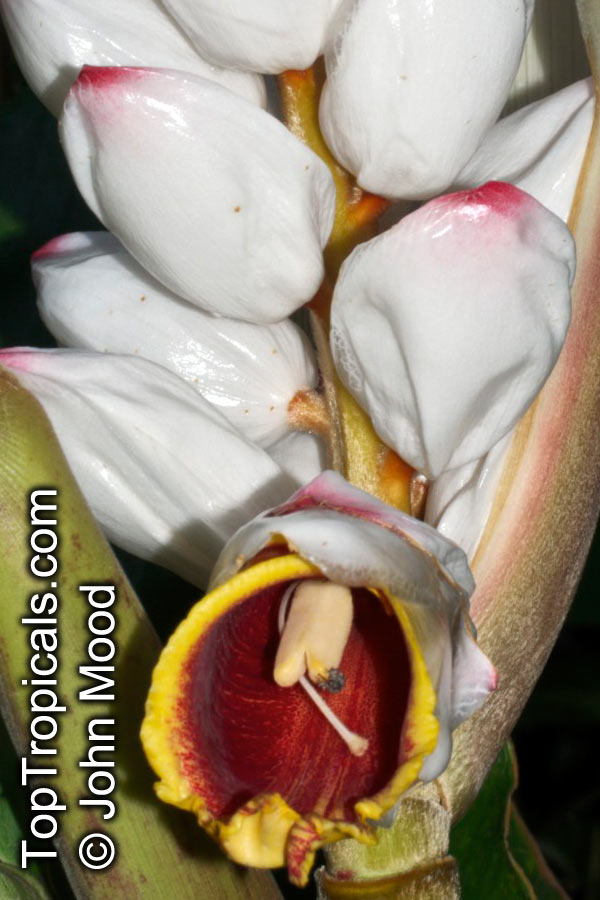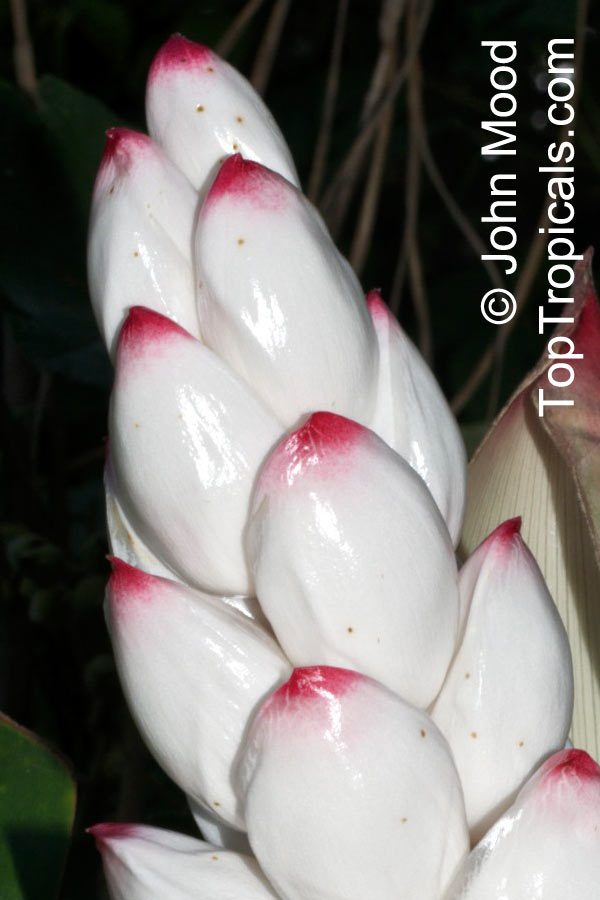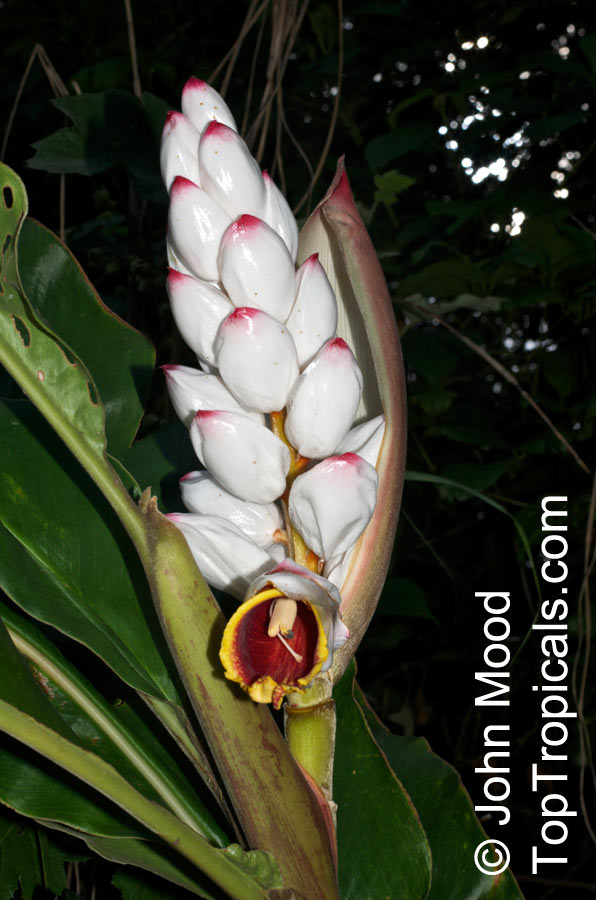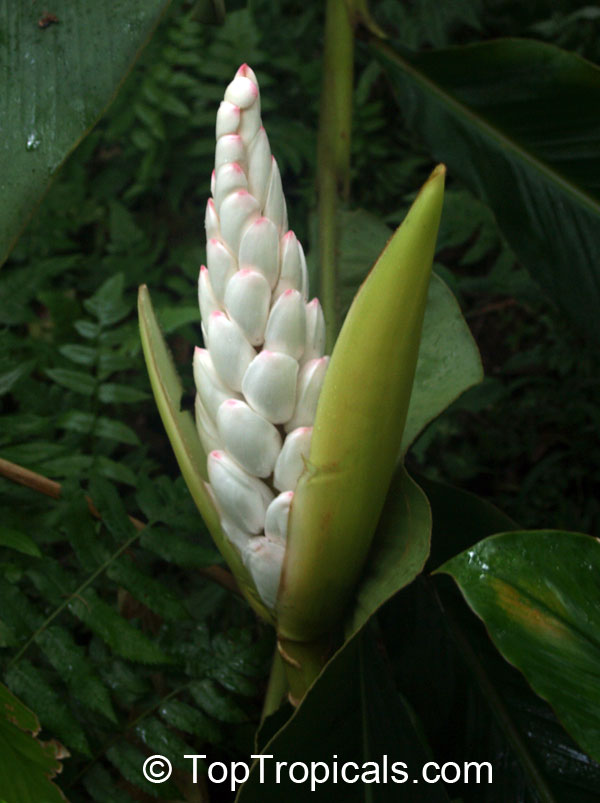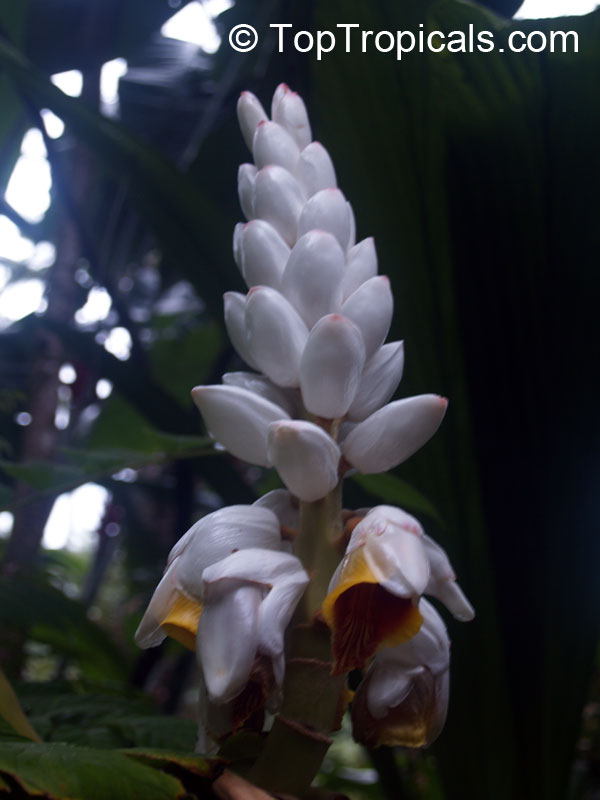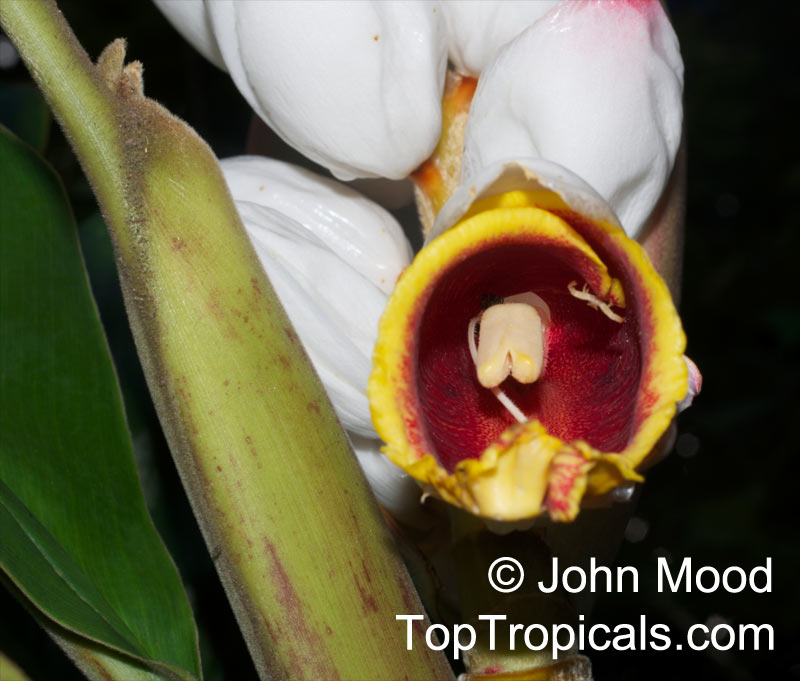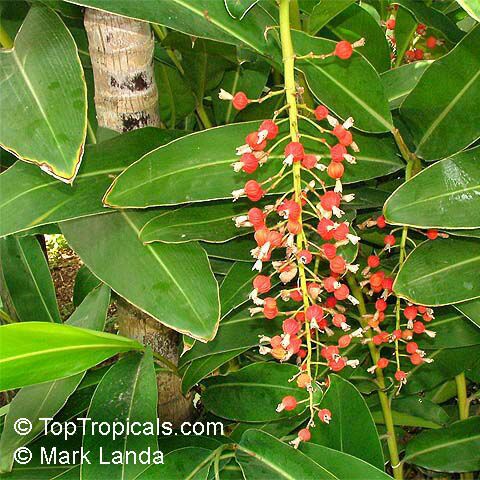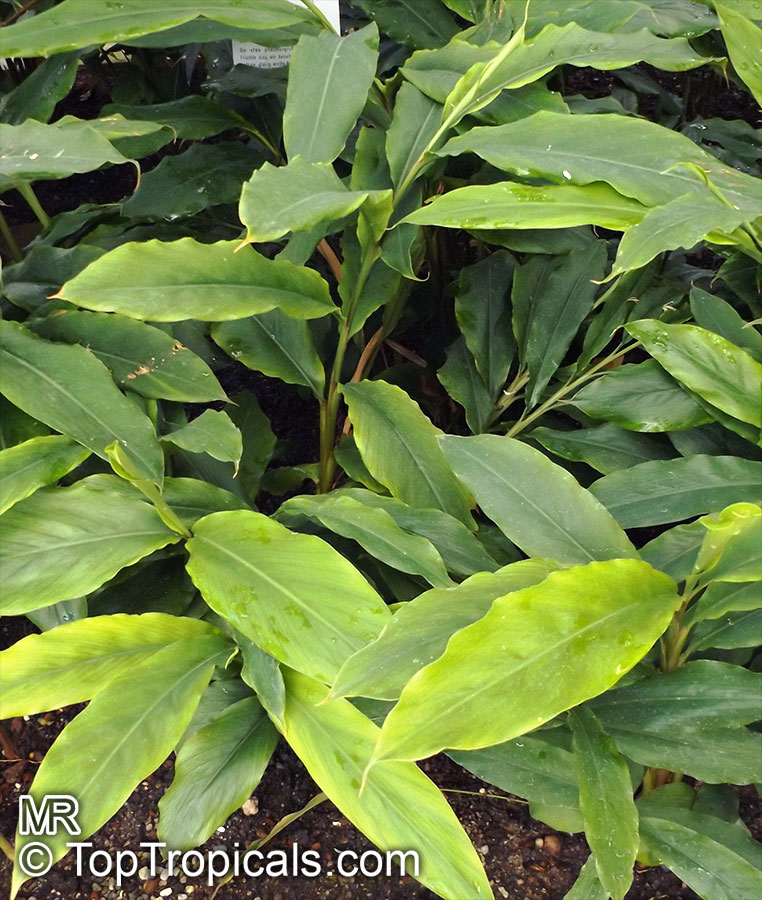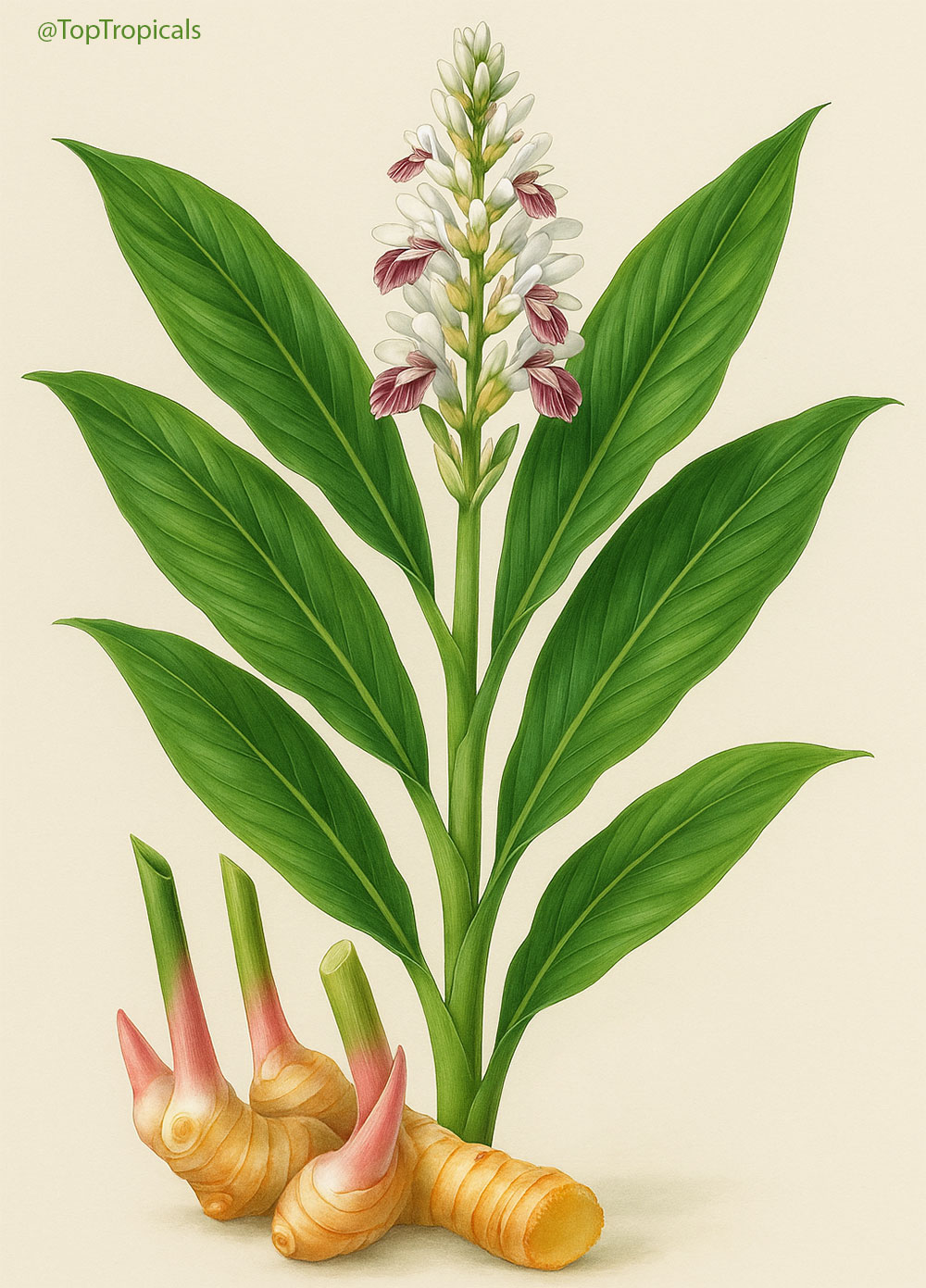Zingiberaceae - Botanical Family
Top Tropicals Plant Encyclopedia
| Number of plants found: 74 | Next | 
|
Go to page: | 1 | 2 | 3 | 4 | 5 | Last |
Botanical name: Aframomum sp.
Common names: Aframomum, Melegueta pepper, Guinea grain, Guinea pepper, Alligator Pepper, Grains of Paradise
Family: Zingiberaceae
Origin: Tropical Africa







The genus Aframomum is well known in African forests because the bright red, fleshy fruit of several species contain a sweet juicy pulp and is eaten widely by primates and other mammals.
Aframomum melegueta is a herbaceous perennial plant native to swampy habitats along the West African coast. Its trumpet-shaped, purple flowers develop into 5- to 7-cm long pods containing numerous small, reddish-brown seeds.
Seeds of this rare Ginger are similar in flavor to cardamom and used as a pungent spice. This Ginger has many bioactives, great for digestive and intestinal health. The plant has many other medicinal values: anti-diabetic and anti-obese mechanisms, aphrodisiac and testosterone boosting properties. Aframomum melegueta may be promising for a spice to add to a diet in hopes of body recomposition. Studies show this spice increases sexual behavior.
Recommended Fertilizer: SUNSHINE Robusta - Rapid Growth Booster
Botanical name: Alpinia argentea
Common name: Yellow Ginger Lily
Family: Zingiberaceae




Alpinia argentea (Yellow Ginger Lily)
Botanical name: Alpinia formosana x zerumbet
Common name: Variegated ginger
Cultivar: Variegata
Family: Zingiberaceae
Origin: South Africa









Alpinia zerumbet 'Variegata' (Variegated ginger) is a small shrub native to South Africa that grows to a height of 2 - 5 feet. The foliage is a glossy green with white and off-white striping, adding interest to the garden.
When planting, gingers prefer soils that are kept moist, so watering regularly is important. In cold regions, it is best planted in a pot as mature plants are cold hardy only to at least 30s F for a short period of time. In order to survive harsh winters, the pot can be brought indoors.
To promote healthy growth, the soil should be well drained with plenty of organic matter. Fertilize twice a year, once in the spring and again in the summer with a balanced organic fertilizer. To further ensure the health of the plant, remove any dead foliage and flowers.
Alpinia zerumbet 'Variegata' is a great choice for the home garden. The colorful foliage and variety of flowers make this species a great ornamental in any garden. With appropriate care and water, this plant is sure to provide pleasure in the garden for many years.
Botanical names: Alpinia galanga, Languas galanga
Common names: Galanga Root, Galangal, Thai Ginger, Laos
Family: Zingiberaceae
Origin: SE Asia









Galanga is an herb used in cooking, especially in Indonesian and Thai cuisines. It is one of four plants known as galangal, and is differentiated from the others with the common name greater galangal (or simply Thai galangal). The galangals are also called blue ginger or Thai ginger.
A. galanga is called laos in Indonesian and is the most common form of galangal used in cooking. It is also known as lengkuas and galanga root.
Botanical names: Alpinia gigantifolia, Zingiber gigantifolium
Common name: Red Ginger Lily
Family: Zingiberaceae







Botanical name: Alpinia henryi
Common name: Pink porcelain lily
Cultivar: Pink Perfection
Family: Zingiberaceae
Origin: Subtropical Asia







Among the best-known members of this genus is Alpinia henryi 'Pink Perfection', a large shrub or small tree reaching 5-10ft in height and 2-5ft in width. Its native habitat is Subtropical Asia, but it can be successfully grown as an ornamental in USDA zones 9-11. It's a hardy and attractive plant, with deep green, glossy foliage and an abundance of pink flowers throughout the year. In the right conditions, it can be a real show-stopper, its flowers being especially fragrant.
Caring for Alpinia henryi 'Pink Perfection' is not particularly difficult. It prefers a spot in full sun or semi-shade, in well-drained soil, and regular watering. Some mulching during the summer can help protect the roots from the heat. It can suffer from frost damage, so if you're growing it in a pot in a cold region, you should move it indoors during the winter months. Also, the plant may suffer from mealybugs, so if you notice their presence it's best to take appropriate action as soon as possible.
In general, Alpinia henryi 'Pink Perfection' is an easy-to-care-for plant that can make a wonderful addition to any garden or conservatory. With its lush foliage, abundant flowers, and heavenly fragrance, it can certainly bring a touch of the exotic and an undeniable beauty to your outdoor spaces.
Botanical name: Alpinia luteocarpa
Common name: Red Bamboo Ginger
Family: Zingiberaceae
Origin: Philippines









This fragrant ginger looks like a dwarf bamboo bush. This Ginger boasts dark green leaves with red undersides. Bamboo Ginger is also a fragrant ginger that looks like a dwarf bamboo bush with a great clumping habit. Perfect patio container plant. Prefers some shade. Mature height of 2-3'. Reaches 2-3' and produces flowers.
The specific epithet luteocarpa means yellow fruit.
Botanical name: Alpinia malaccensis
Common name: Rathkihiriya
Family: Zingiberaceae
Origin: Indonesia











Alpinia malaccensis is cultivated for ornamental and medicinal purposes. It is a native of Indonesia and Malaysia. An oil is obtained from dried rhizome. The rhizomes are ginger-scented. Likes a slightly acid soil. Tubular flowers in droopy clusters. The flowers come mostly in summer.
Alpinia malaccensis is similar to Alpinia nutans
Botanical names: Alpinia nutans, Alpinia speciosa
Common names: Shell ginger, Pink porcelain lily, Narrow-Leaf Cinnamon Ginger, Shellflower, Dwarf cardamom, False cardamom
Family: Zingiberaceae
Origin: China and Japan
Hardiness: 20°F











The plant is quite versatile and makes for an excellent garden plant in USDA growing zones 7-9. It can either be grown as a large shrub of 5-10 feet in height or as a small shrub of 2-5 feet. Alpinia nutans requires full sun or partial shade, but prefers humid conditions and regular watering. Its stunning hot pink flowers, borne atop long flowering stems, bloom beginning in June and continue until the Fall.
It is a fairly salt tolerant plant, making it suitable for seaside areas. In cold climates, the mature plant is hardy at least to the low 30s Fahrenheit for a short time, although for best results it should be grown in a pot and stored in an area that does not freeze in the winter, such as a greenhouse or garage. Watering should be reduced in cold conditions and kept to a minimum until warm weather resumes. During the spring, the rhizome should be restrained or it will overthrow its container. Plants should be repotted in the spring if they outgrow their original container. Fertilize annually with compost or an appropriate plant food to encourage growth, and do regular pest and disease checks.
Alpinia nutans is similar to Alpinia malaccensis and Alpinia zerumbet. Alpinia nutans var. longiramosa is a synonym of Alpinia zerumbet.
Botanical name: Alpinia officinarum
Common name: Lesser Galangal
Family: Zingiberaceae
Origin: China










Galanga Root, Lesser Galangal, Thai gingeris more than just a fast growing ornamental ginger and flavorful root - it's also a powerful healing plant with centuries of use in both kitchens and traditional medicine. It supports digestion, reduces inflammation, boosts circulation, and helps fight infections with its natural antimicrobial properties. Rich in antioxidants, galangal may also support brain health and relieve respiratory issues. A must-have plant for both cooking and wellness.
It has long narrow leaves and reddish-white flowers. Galanga is an herb used in cooking, especially in Indonesian and Thai cuisines. The rhizomes, known as galangal, are valued for their spicy flavor and aromatic scent. These are used throughout Asia in curries and perfumes, and were previously used widely in Europe.
Alpinia officinarum (Lesser Galangal) is typically measuring 5-10 feet in height. It prefers semi-shade and regular watering, but will tolerate moderate water during dry spells. The flowers are a cluster of pink, white, or off-white blossoms, giving a beautiful display.
It is not just an ornamental plant. In China, it is also valued for its ethnomedical properties, used as a spice or a herb. Grown across USDA zone 9-11, it can easily be grown in pots in cold regions.
For proper care and growth, this plant requires a slightly acidic and well-drained soil. Provide light shade if grown outdoors, and ensure the pot is well-drained for optimal water retention. Water the plant regularly, but avoid excessive wetting of the soil. It will thrive under the right conditions and can last for years.
Fertilize Alpinia officinarum with a balanced formula throughout the growing season.
Alpinia officinarum is a beautiful, versatile plant. With proper care and maintenance, it will thrive and bring a splash of color and fragrance to any garden.
The rhizomes, known as galangal, are valued for their spicy flavor and aromatic scent. These are used throughout the world in curries and perfumes.
| Next |  |
Use link to repeat this search:
https://toptropicals.com/cgi-bin/garden_catalog/cat.cgi?search_op=and&keyword_op=and&language=e&family=Zingiberaceae
&number=10&no_change_lang=1&user=tt&sale=1&first=0
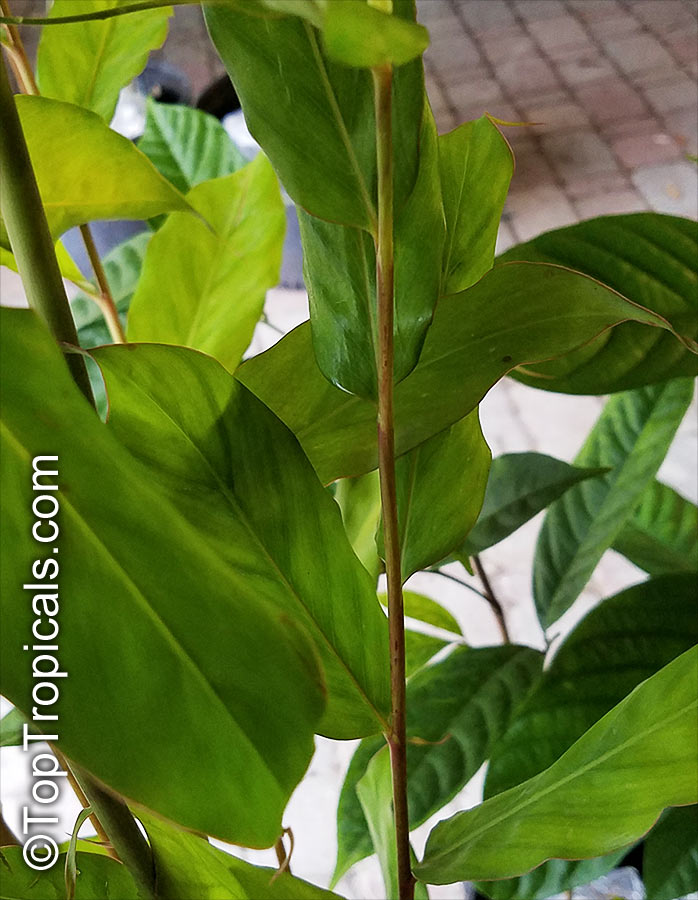
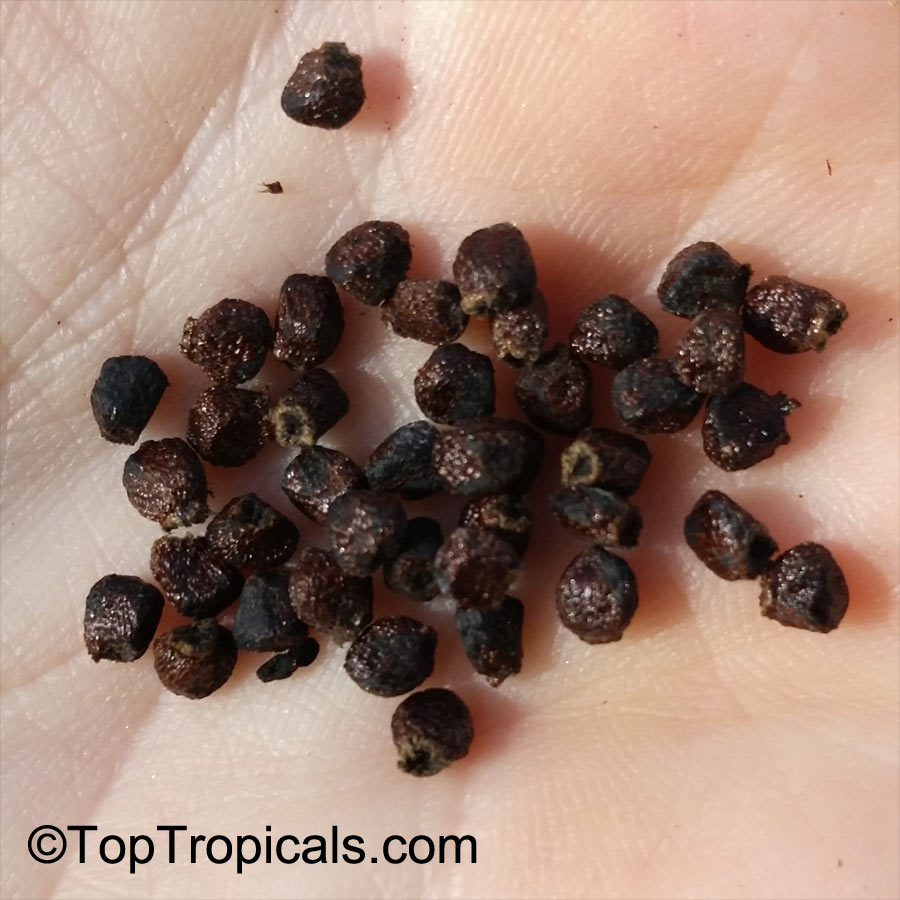
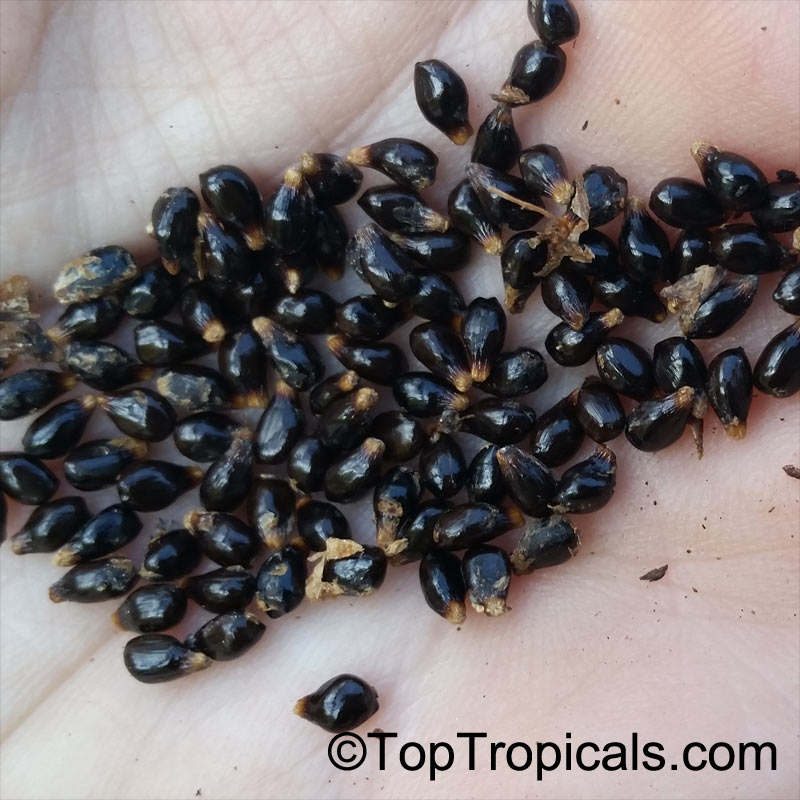
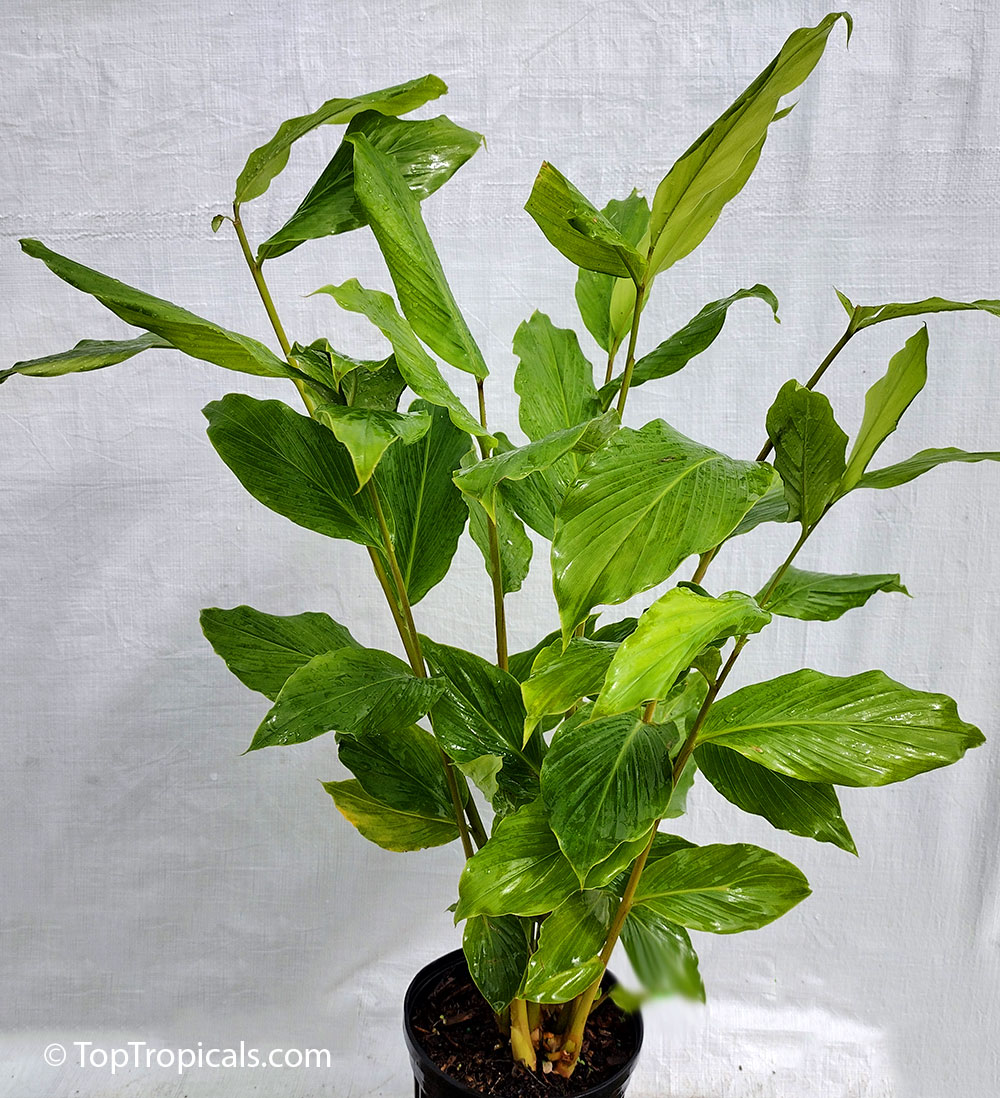
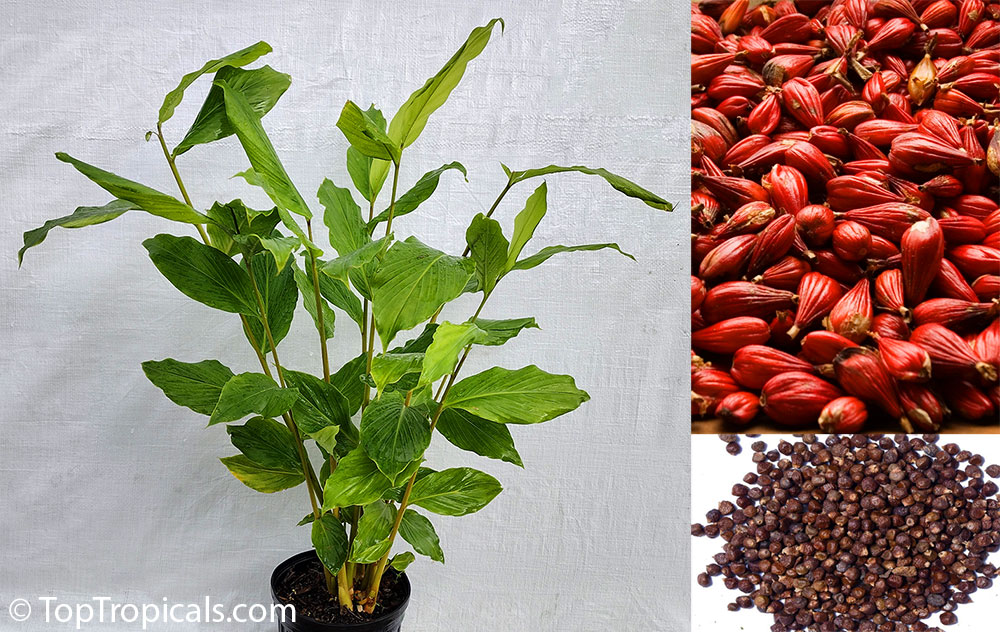
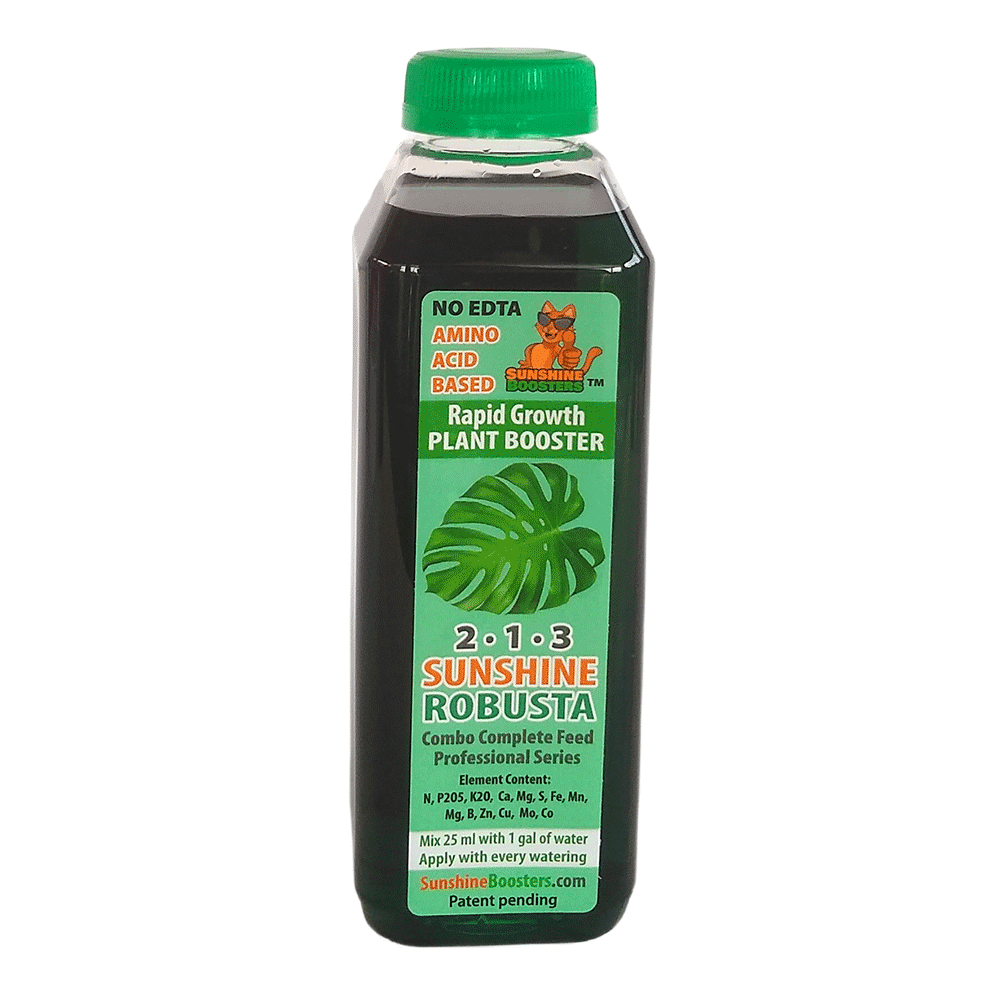 SUNSHINE Robusta (NPK 2-1-3) - Vegetative Vigor Booster for every watering. Formulated especially for vegetative stage of plant development. Can be used for a quick build-up of vegetative growth, for establishing and recovering damaged plants that lost many leaves. This is an eco-friendly nutrition booster that can be used for edibles and organic gardens. Can be used for daily feeding with every watering. Scientifically-balanced stable formula is organic Amino-acid based and has NO EDTA chelators to eliminate nutrients lockup; it does not affect crop taste. Organic Amino acids greatly enhance stability of all Sunshine boosters and provide excellent absorption of trace elements. Pollinating insects friendly.
SUNSHINE Robusta (NPK 2-1-3) - Vegetative Vigor Booster for every watering. Formulated especially for vegetative stage of plant development. Can be used for a quick build-up of vegetative growth, for establishing and recovering damaged plants that lost many leaves. This is an eco-friendly nutrition booster that can be used for edibles and organic gardens. Can be used for daily feeding with every watering. Scientifically-balanced stable formula is organic Amino-acid based and has NO EDTA chelators to eliminate nutrients lockup; it does not affect crop taste. Organic Amino acids greatly enhance stability of all Sunshine boosters and provide excellent absorption of trace elements. Pollinating insects friendly.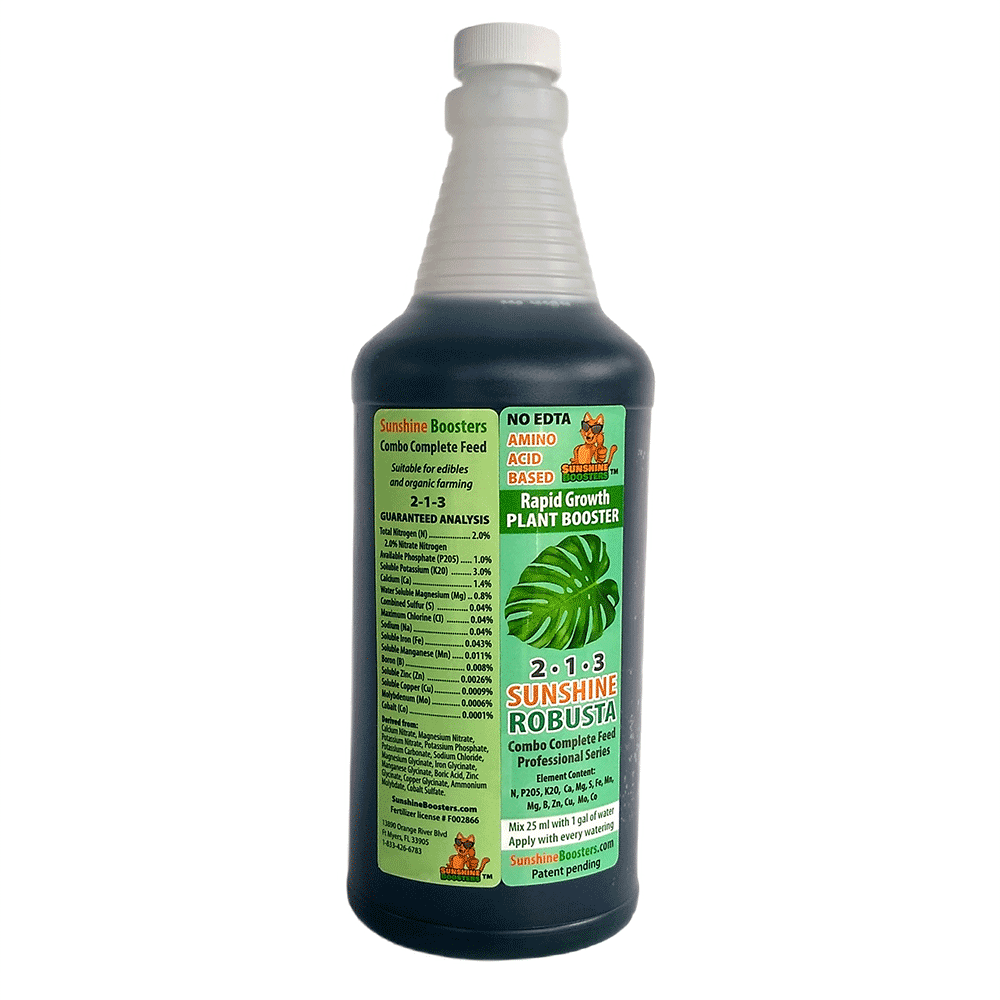 SUNSHINE Robusta (NPK 2-1-3) - Vegetative Vigor Booster for every watering. Formulated especially for vegetative stage of plant development. Can be used for a quick build-up of vegetative growth, for establishing and recovering damaged plants that lost many leaves. This is an eco-friendly nutrition booster that can be used for edibles and organic gardens. Can be used for daily feeding with every watering. Scientifically-balanced stable formula is organic Amino-acid based and has NO EDTA chelators to eliminate nutrients lockup; it does not affect crop taste. Organic Amino acids greatly enhance stability of all Sunshine boosters and provide excellent absorption of trace elements. Pollinating insects friendly.
SUNSHINE Robusta (NPK 2-1-3) - Vegetative Vigor Booster for every watering. Formulated especially for vegetative stage of plant development. Can be used for a quick build-up of vegetative growth, for establishing and recovering damaged plants that lost many leaves. This is an eco-friendly nutrition booster that can be used for edibles and organic gardens. Can be used for daily feeding with every watering. Scientifically-balanced stable formula is organic Amino-acid based and has NO EDTA chelators to eliminate nutrients lockup; it does not affect crop taste. Organic Amino acids greatly enhance stability of all Sunshine boosters and provide excellent absorption of trace elements. Pollinating insects friendly.